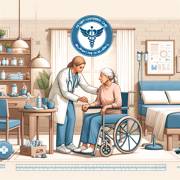Best Practices in Home Health CareHome health care is an essential component of the healthcare system, providing patients with medical services in the comfort of their own homes. The VNAA Blueprint for Excellence is a pivotal resource that promotes best practices in this field, emphasizing quality improvement and workforce training. By adopting these practices, providers can enhance patient outcomes and reduce healthcare costs. Patient-Centered Care Patient-centered care is a fundamental principle in home health care, focusing on the individual needs and preferences of patients. This approach ensures that care plans are tailored to each patient's unique circumstances, promoting better health outcomes and patient satisfaction. One of the key aspects of patient-centered care is involving patients and their families in decision-making processes. This involvement empowers patients, giving them a sense of control over their health journey. According to a 2022 study by the Agency for Healthcare Research and Quality (AHRQ), patient engagement can lead to improved adherence to treatment plans and reduced hospital readmissions. Moreover, patient-centered care emphasizes cultural competence, recognizing the diverse backgrounds of patients. By understanding cultural differences, healthcare providers can offer more personalized and respectful care. This approach not only improves communication but also builds trust between patients and caregivers. Interdisciplinary Team ApproachAn interdisciplinary team approach is crucial for delivering comprehensive home health care. This model involves collaboration among various healthcare professionals, including nurses, therapists, social workers, and physicians. Each team member brings unique expertise to address the complex needs of patients. Effective teamwork ensures that all aspects of a patient's health are considered. For instance, while a nurse may focus on medication management, a physical therapist can work on mobility issues. This holistic approach leads to more coordinated and efficient care delivery. The benefits of an interdisciplinary team are well-documented. A 2021 report from the National Institute for Health Care Management (NIHCM) found that interdisciplinary teams can reduce emergency room visits by up to 30% and improve patient satisfaction scores significantly. Effective Communication StrategiesCommunication is at the heart of successful home health care. Effective communication strategies ensure that information flows seamlessly between patients, families, and healthcare providers. This clarity prevents misunderstandings and enhances the quality of care provided. Active listening is a critical component of effective communication. Healthcare providers must attentively listen to patients' concerns and preferences to tailor interventions accordingly. Additionally, using simple language free from medical jargon helps patients understand their conditions better. Regular updates through various channels—such as phone calls, emails, or home visits—keep everyone informed about the patient's progress. A 2023 survey by the Journal of Medical Internet Research highlighted that consistent communication reduces anxiety among patients and their families by over 40%. Comprehensive Care PlanningComprehensive care planning involves developing detailed strategies to address all aspects of a patient's health needs. These plans should be dynamic documents that evolve based on ongoing assessments and changing patient conditions. Care plans typically include goals for treatment, specific interventions required, timelines for achieving these goals, and criteria for evaluating success. Involving patients in this planning process ensures that their values and preferences are respected. An effective care plan requires regular reviews by the interdisciplinary team to ensure it remains relevant. Data from a 2023 study published in Health Affairs shows that well-structured care plans can decrease hospitalization rates by nearly 25% among chronic disease patients receiving home health services.
| Component |
Description |
| Goals |
Desired outcomes for treatment |
| Interventions |
Specific actions needed |
| Timelines |
Expected timeframes for achieving goals |
| Evaluation Criteria |
Measures used to assess progress |
Utilization of Technology in Home Health Care
The utilization of technology has revolutionized home health care delivery over recent years. Innovations such as telehealth platforms enable remote consultations with specialists without requiring physical travel—a boon during times like pandemics when minimizing exposure risks becomes paramount.
Wearable devices like smartwatches track vital signs continuously while sending real-time data back to healthcare providers who monitor trends closely—enabling early intervention if abnormalities arise before they escalate into serious issues requiring hospitalization or emergency intervention.
Additionally—and perhaps most importantly—electronic health records (EHRs) facilitate seamless information sharing across different members within an interdisciplinary team; ensuring everyone remains updated regarding changes made during previous visits thereby preventing duplicative efforts while optimizing resource allocation efficiently!
Quality Improvement and Performance Measurement
Continuous quality improvement (QI) processes are integral components within any successful home healthcare organization aiming towards excellence consistently! By measuring performance metrics regularly—such as patient satisfaction scores or clinical outcome indicators—it becomes possible not only identify areas needing enhancement but also implement targeted interventions designed specifically addressing those shortcomings effectively!
Organizations utilizing QI frameworks often rely upon evidence-based guidelines derived from reputable sources like Centers Medicare & Medicaid Services (CMS) which provide benchmarks against industry standards ensuring accountability transparency throughout entire operation cycle ultimately leading higher levels overall performance satisfaction amongst stakeholders involved directly indirectly alike!
In addition regular audits conducted internally externally help maintain compliance regulatory requirements safeguarding integrity reputation long-term sustainability operations themselves!
- Regular performance evaluations
- Implementation based on evidence-based guidelines
- Internal & external audits
Workforce Training and Development
Investing heavily into workforce training development programs remains crucial aspect sustaining high-quality service provision amidst ever-evolving landscape modern-day healthcare environment! Ensuring staff members receive ongoing education opportunities keeps them abreast latest advancements technologies methodologies thus enhancing competency levels professionalism exhibited daily basis interactions clients colleagues alike!
Training initiatives should encompass wide range topics spanning clinical skills soft skills necessary fostering effective communication empathy compassion towards those under care further strengthening bonds formed naturally throughout caregiving process itself!
Moreover mentorship programs pairing experienced practitioners newer recruits facilitate knowledge transfer smooth transition newcomers adapting organizational culture expectations seamlessly contributing positively organizational growth overall success achieved collectively together!
|